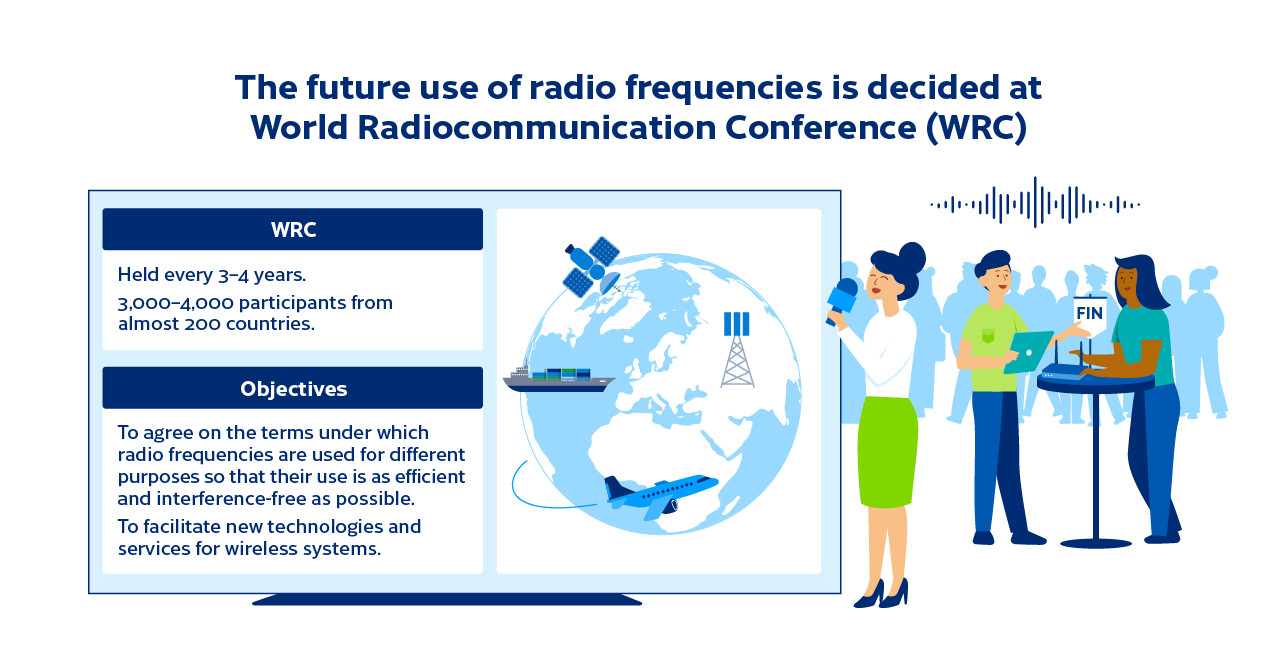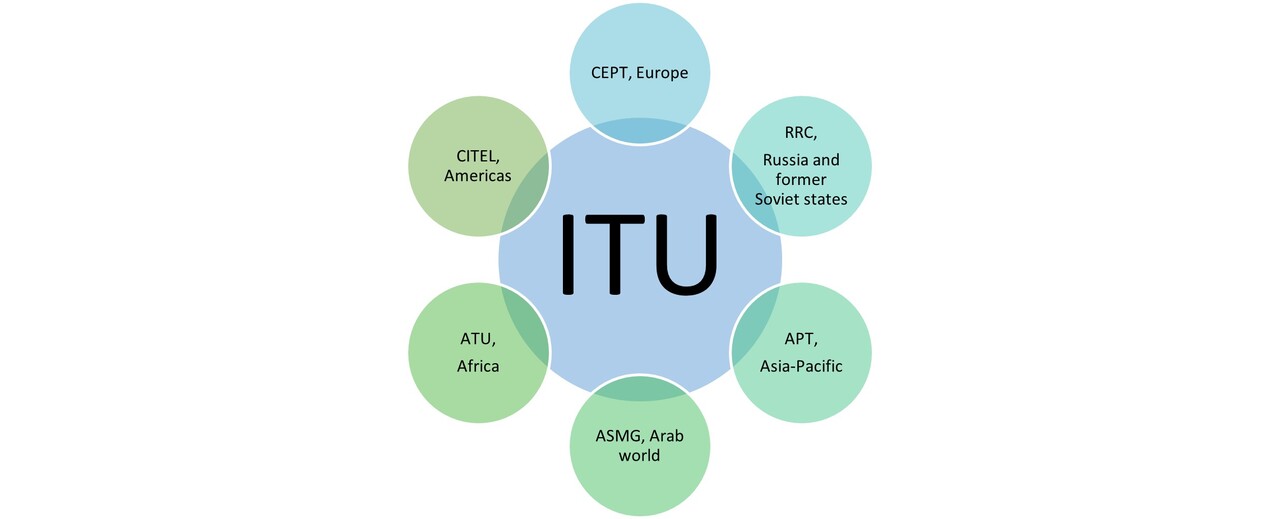World Radiocommunication Conferences (WRC), which are organised by the International Telecommunication Union (ITU) operating under the United Nations, are held every 3–4 years to decide on the future use of radio frequencies around the world. The purpose of the WRCs is to review and, if necessary, revise the Radio Regulations, the international treaty governing the use of the radio-frequency spectrum and satellite orbits.
As the radio-frequency spectrum continues to fill up, mobile networks, satellite systems, aeronautical and maritime radio systems and other user groups are forced to compete over increasingly scarce radio frequency resources. What most of these radio systems and user groups have in common is the need to harmonise the use of radio frequencies regionally or globally. The terms under which radio frequencies are used for different purposes are agreed upon at World Radiocommunication Conferences so that their use is as efficient and interference-free as possible.
The changes to the purposes and terms of use of radio frequencies agreed upon at World Radiocommunication Conferences are recorded in the revised Radio Regulations. The Radio Regulations define the boundary conditions and rules for how radio frequencies are used in different parts of the world. The international decisions made at World Radiocommunication Conferences have a decisive impact on how radio frequencies can be used in the future to meet the various needs of the wireless communications networks and services that Finland’s information society relies on.
WRC preparation is long-term work – the 2023 conference in Dubai concludes a four-year study cycle and starts another
World Radiocommunication Conferences are held every 3–4 years, and WRC-23 was held in Dubai in the United Arab Emirates from 20 November to 15 December 2023. The conferences are attended by 3,000–4,000 representatives from nearly all of the ITU’s 193 Member States. The previous WRC held in 2019 was attended by a total of 3,400 people from 163 Member States.

International radio frequency work always involves looking several years ahead, as evidenced by the fact that the agenda of each World Radiocommunication Conference is approved at the previous conference. In other words, the agenda for WRC-23 was approved at the previous WRC-19, and the agenda for WRC-27 was approved at WRC-23. During the technical study cycles between conferences, the ITU’s study groups carry out technical compatibility studies to determine the feasibility of each WRC agenda item and prepare proposals on them to be ultimately decided upon at the next conference. Finland’s representative in this technical preparation carried out by the ITU is Traficom together with its stakeholders.
The agenda for WRC-23 included approximately 20 different items related to the use of radio frequencies. The primary areas of study at each conference are mobile communication, satellite systems, aeronautical and maritime radio systems, and science and research. All of these sectors typically have extensive needs when it comes to the use of radio frequencies, providing good examples of why the use of radio frequencies needs to be harmonised both regionally and globally – after all, radio frequencies do not stop at national borders.
WRC preparation is carried out both nationally and internationally
As regards Finland, WRC preparation is carried out at three different levels: nationally (cooperation with stakeholders), at the European level (CEPT/EU) and at the global level (ITU).
At the national level, the Ministry of Transport and Communications appoints the national preparatory working group for the WRC to collect the sector’s views on each WRC agenda item and to assist ministries in establishing Finland’s national positions. The national preparatory working group works on communication policy issues related to preparation for WRCs. The working group also has a technical working group led by the Finnish Transport and Communications Agency Traficom operating under it, which works on radio technology issues related to WRC preparation.
At the European level, WRC preparation related to technical matters is primarily carried out by the European Conference of Postal and Telecommunications Administrations (CEPT). The purpose of this work is to prepare European common proposals for the different items of the WRC agenda. For example, for WRC-23, CEPT prepared a total of 252 European common proposals. The Council of the European Union approves the WRC decision, which establishes the EU’s position on the WRC agenda items that impact EU legislation. The Council of the European Union’s decision is binding for all EU Member States. Finland’s negotiating positions and commitment to European common proposals are decided by the Ministry of Transport and Communications.
At the global level, technical preparation for all WRC agenda items is carried out by the ITU. The work is contributed to by all six regional bodies that carry out regional-level studies, including CEPT in Europe. All the technical solutions and alternatives for addressing WRC agenda items prepared as a result of this work are recorded in a single report.

WRCs allocate new radio frequencies for mobile communication
Decisions on the global harmonisation of mobile network radio frequencies and technologies were first issued at the 1992 conference. Subsequent WRCs have allocated several additional radio frequency bands for 3G/4G/5G mobile networks, i.e. IMT systems.
| WACR-1992 | 1885-2025 MHz and 2110-2200 MHz |
| WRC-2000 | 806-960 MHz, 1710-1850 MHz and 2500-2690 MHz |
| WRC-2007 | 450-470 MHz, 698-806/862 MHz, 2300-2400 MHz and 3400-3600 MHz |
| WRC-2012 | 694-790 MHz |
| WRC-2015 | 470-694 MHz, 1427-1518 MHz, 3300-3400 MHz, 3400-3600 MHz, 3600-3700 MHz and 4800-4990 MHz |
| WRC-2019 | 24.25-27.5 GHz, 37-43.5 GHz, 45.5-47 GHz, 47.2-48.2 GHz and 66-76 GHz |
Table 1. Frequencies assigned to mobile communication networks. Not all frequency bands listed in the table are available in Europe.
The need for additional radio frequencies for mobile communications is caused by the rapid increase in the use of mobile networks and subsequent need for more network capacity. Almost all of the frequency bands allocated for mobile communications at WRCs (a total of 19.15 GHz of frequencies) have been globally harmonised, enabling the same terminal equipment to be used everywhere in the world. In other words, this means that we do not need to buy new smartphones when traveling from one continent or country to another.
One of the aims of WRC-23 was to allocate more radio frequencies for mobile communication use in the 3 GHz, 6 GHz and 10 GHz frequency bands. The most important of these nationally is the 6 GHz frequency band. In addition to this, WRC-23 included discussion about whether the potential need for additional radio frequencies for 6G systems should be addressed at the 2027 WRC.
Since 2007, Finland has also been advocating for the allocation of the TV frequency band 470–694 MHz for parallel primary mobile communication use. Finland considers it important to add flexibility to the Radio Regulations, especially as regards this frequency band, as this would facilitate the efficient and timely use of radio frequencies for different systems based on national decisions.
As regards aeronautical radio systems, the most important issue is to enable the use of VHF connections via satellites as well in areas not covered by terrestrial aviation base stations. In addition to this, the aim is to allocate new radio frequencies in the 15 and 22 GHz frequency bands for non-security related aeronautical use.
As regards maritime radio systems, the aim is to add clarifications to the Radio Regulations concerning the modernisation of the Global Maritime Distress and Safety System (GMDSS).
Radio frequencies for space communication facilitate research and the development of satellite systems
The agenda for WRC-23 included several items related to space research and the use of radio frequencies by satellites. Space research is a growing sector due to applications supporting climate change monitoring, among other things. As such, one of the aims of WRC-23 was to make decisions on issues such as the use of the 40–50 MHz frequency band by low Earth orbit (400 km) Earth exploration-satellites. Since these low frequencies are relatively effective for penetrating the Earth’s crust, such satellites could be used to examine underground water reserves and glacial structures for the purpose of drawing conclusions about the different stages of climate change.
Another aim of WRC-23 was to allocate frequencies for Earth observation satellites to measure so-called ice clouds using high frequencies of approximately 240 GHz. Such measurements could facilitate more accurate weather forecasts and also contribute to the study of climate change phenomena. Also on the agenda for WRC-23 are space weather sensors, which can be used to collect data on the effects of space weather and forecast its impacts on terrestrial energy and telecommunications networks, flight traffic, satellite systems or the accuracy of satellite positioning, for example.
The future of radio frequencies – WRC27 agenda
The agenda for the next conference (WRC-27) and the division of work between different preparatory working groups during the preceding study cycle were largely decided at WRC-23. Based on the preparatory work carried out thus far, it seems likely that the role of radio frequency issues related to satellite systems and space research will continue to increase in the next few years. Security is also an area that has been recognised as being important in terms of the use of radio frequencies in satellite systems and space research, which will be reflected in the upcoming study cycle. In addition to this, the fact that Finland recently joined NATO will make the monitoring of WRC agenda items relevant to NATO an important part of Finland’s national preparation.
Technological development is rapid, and the need for radio frequencies in different sectors is constantly increasing. Because of this, World Radiocommunication Conferences are an important part of international radio frequency cooperation. When it comes to WRC preparation and the conferences themselves, we, too, are aiming far into the future to facilitate the development of communications networks and services in Finland.
Go back to the page “Radio frequencies now and in the future" (External link)